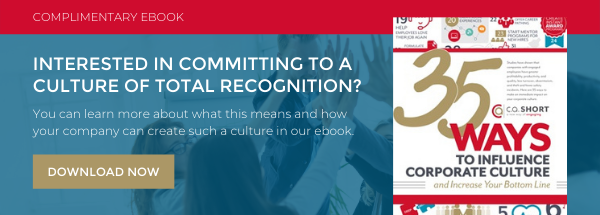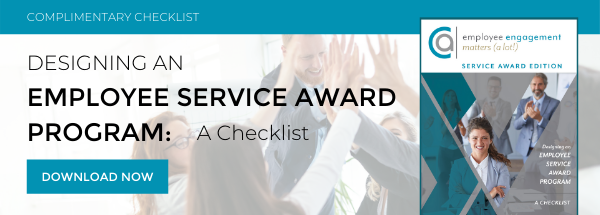Years of Service: Traditional Work Anniversary Awards

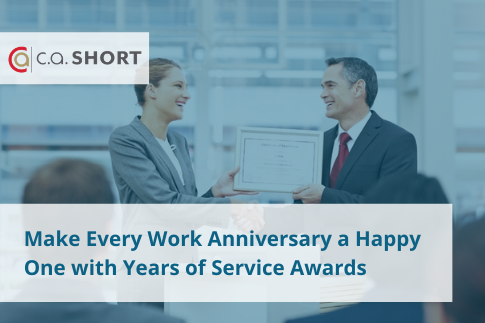
Part 1: The importance of celebrating work anniversaries with Years of Service awards
- What are Years of Service awards?
- Why is it important to recognize an employee’s work anniversary?
- The benefits of an engaged and recognized workforce
Part 2: Best practices for celebrating work anniversaries with years of service awards
- When should you begin honoring employees for their years of service?
- 15 best practices for offering Years of Service awards
Part 3: Working with a SaaS provider to implement your YOS awards
- How do values-based incentive points programs work?
- Benefits of values-based incentive programs
- How a SaaS provider can help
- Next steps
Part 1: The importance of celebrating work anniversaries with Years of Service awards
More than 80 years ago, C.A. Short Company decided that we would do things differently. At a time when employers were demanding more and more from their employees while offering them less and less, we believed there was a better way.
We knew we could help create an environment where everyone wins – and we mean everyone.
In fact, to realize the greatest profits possible, there must be three clear winners:
- the organization and its stakeholders
- their customers, clients and partners, and – above all –
- their employees
When synergy occurs between these three groups, the results are dramatic.
How does a company achieve this?
Employee recognition plays a vital role in this process, and a core component of every successful recognition strategy lies in the effectiveness of one’s Years of Service, or Work Anniversary award program.
What are Years of Service awards?
Years of Service awards. Employee Milestone awards. Work Anniversary awards.
It doesn’t matter what you call them, it all means the same thing – formally honoring your employees for their loyalty and commitment to your organization. Typically this involves a once-a-year ceremony where a small number of employees are recognized for hitting a noteworthy work anniversary.
In the old days, employers would wait until an employee’s five-year anniversary to honor them. Yet, as we will discuss in detail further on, waiting until the five-year mark before rewarding an employee’s loyalty no longer makes sense.
Years of Service (YOS) awards still deliver tremendous results – if you know how to adapt them to today’s dynamic workforce. Before we show you how to do this, let’s take a closer look at why Years of Service awards play such a vital role in the success of your company.
Why is it important to recognize an employee’s work anniversary?
Lack of employee recognition in the workplace
There is a frightening lack of employee recognition in today’s workplace, and it’s having an unprecedented impact on the workforce. To understand the challenges many businesses face, we need to look no further than the transportation industry.
Last year, it hit a record-setting shortage of drivers – a trend that shows no signs of slowing down. Turnover rates also skyrocketed to more than 90%.
Don’t think the transportation industry is alone! Thousands of businesses across the nation shutter their doors on a yearly basis. And we’re not just talking about struggling mom and pop operations – we’re talking about juggernauts.
Toys ‘R’ Us. H.H. Gregg. Radio Shack.
These are all examples of once-great businesses that filed for bankruptcy. What’s more shocking is that these bankruptcies all occurred in the same year – and they represent just a few of the many businesses that folded in 2017.
We’ll leave others to speculate about the specific missteps each company made. Instead of discussing failure, we’ll discuss success. You see, what we’ve learned throughout our 80+ years in the employee recognition industry is that employees who are engaged and recognized can take on ANY challenge thrown their way.
Unfortunately, many employers fail to see the connection between employees and customers — and it costs them some of their best talent. As we mentioned above, employee turnover has skyrocketed in recent years. Do you know the number one reason most employees leave their jobs?
They don’t feel appreciated.
.png?width=500&name=unnamed%20(33).png)
.png?width=500&name=unnamed%20(34).png)
.png?width=512&name=unnamed%20(35).png)
In a recent survey, 66% of respondents say they would quit their jobs if they didn’t feel appreciated. When it comes to millennials, who will very quickly make up a majority of the U.S.
workforce, that number increases to a staggering 75%.
They’re not making an empty threat either. Millennials are more likely to leave their job than any other generation in history. In fact, six out of 10 millennials say they’re open to a new job right now, and nearly 25% have changed jobs within the past 12 months.
For the purposes of this resource, we’ll focus on statistics and proven strategies that relate to all generations in the workforce. However, if you’d like to learn tactics and strategies you can use with millennial employees, you can download our complimentary eBook, “A Guide to Retaining Top Millennial Talent.”
The benefits of an engaged and recognized workforce
The above stats may paint a dire picture of today’s workforce, but you shouldn’t let them discourage you. In fact, they should inspire you.
How could these statistics be inspirational?!?!
Because they mean you have a real, tangible opportunity to differentiate yourself from the millions of other employers around the globe. When a company invests in creating a comprehensive Culture of Engagement and Recognition at their organization, current and prospective employees take notice.
And that’s just one of the many benefits a highly engaged and properly recognized workforce yields.
Back in 2017, Gallup released an update to their eye-opening study, State of the American Workplace. The report is fantastic, and you should make time to read it in its entirety. However, here are a few standouts you need to know NOW.
By comparing companies that score in the top quartile of employee engagement and recognition to businesses scoring in the bottom quartile, Gallup discovered that top-performing organizations experience:
- Reductions in turnover that range from 24% to nearly 60%
- 41% reduction in employee absenteeism
- As much as 70% fewer safety incidents
- Reduced patient safety incidents, by nearly 60%
- 28% reduction of shrinkage
- 40% fewer quality defects
- 10% improvement in customer metrics
- 17% higher productivity levels
- 20% more sales than their competitors
- Profitability increases by as much as 21%
How do Years of Service awards factor into a Total Recognition strategy?
If an organization hopes to achieve any or all of the benefits listed above, it must first commit to a Culture of Total Recognition. You can learn more about what this means (and how your company can create such a culture) in our ebook on the topic.
But for now, let’s stick to the basics.
Total Recognition occurs when a business recognizes employees across three core levels: formal recognition, informal recognition, and day-to-day recognition. If a recognition strategy is missing any one of these levels, it will prevent the business from obtaining Total Recognition. As a result, they will miss out on the benefits of a highly engaged and recognized workforce.
Years of Service awards play a vital role in the first of these core areas – formal recognition.
Part 2: Best practices for celebrating work anniversaries with Years of Service awards
Years of Service awards are an excellent way to show your employees how much you, and the entire organization, value their loyalty, commitment, and contributions.
However, if your Years of Service award program isn’t properly structured, it will fail to deliver the results you’re seeking. And in many cases, a poorly planned program can have a negative impact! That’s why it’s critical organizations follow best practices when planning and executing their YOS award program.
This chapter is dedicated to helping businesses do just that.
 When should you begin honoring employees for their years of service?
When should you begin honoring employees for their years of service?
Determining when to offer awards to your employees will have a detrimental impact on the effectiveness of your entire recognition strategy.
Companies have historically waited until an employee’s five-year anniversary before formally acknowledging and rewarding them with a Years of Service award. However, you must recognize employees for their service much sooner in today’s job market.

The standard school of thought suggests starting at the two- or three-year mark. In many cases, companies shouldn't even wait this long before formally recognizing employees. In industries and businesses with high turnover, we recommend they start honoring employees at the one-year mark.
By offering quality awards sooner, companies have been able to dramatically reduce their turnover and improve employee retention.
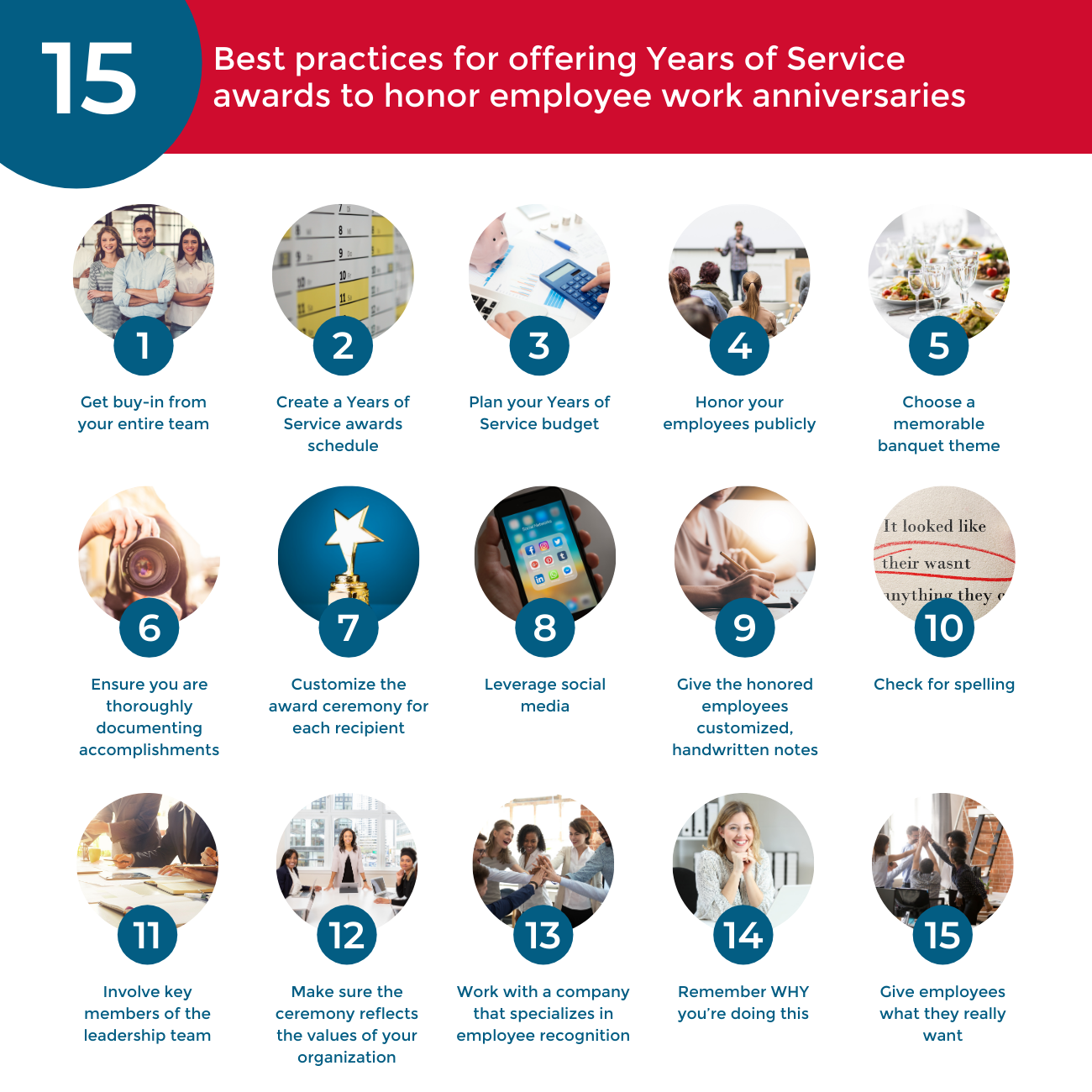
15 best practices for offering Years of Service awards to honor employee work anniversaries
In addition to offering awards sooner, you should also consider the following best practices when creating, implementing, and managing your YOS program.
1. Get buy-in from your entire team
When we say you should get buy-in from your entire team, we mean EVERYONE. This includes the decision-makers at your organization, senior members of management, full-time and part-time employees, and even summer interns!
Everyone in your organization should be aware that your company values its employees, recognizes them for their hard work, and rewards them for their loyalty.
2. Create a Years of Service awards schedule – and be consistent!
One of the first decisions your organization must make is establishing a schedule for when you will offer employees Years of Service awards. Again, we recommend starting sooner rather than waiting for the traditional 5-year work anniversary.
You might even consider offering new employees a welcome package.
Once the award criteria are established, you must stick to the schedule. Consistency is key here.
If Frank gets an award when he reaches the two-year marker, Dave must also get one for serving the same length of time. If these rules aren’t uniformly applied, your awards program will disengage workers and create hostility in the workplace.
3. Plan your Years of Service budget
When creating a budget for your Years of Service award program, you’ll need to be as thorough as possible. Keep in mind, you must factor in more than the cost of the individual rewards you’re giving employees. You must also consider the cost of the award itself, whether it’s a certificate, a trophy, a plaque, or any other commemorative item you choose. You’ll also need to plan the budget for the award ceremony itself.
Companies typically spend around $25 to $35 per year the employee has been with the company. So, at a 10-year award ceremony, employees would receive an award that costs somewhere around $250 — $350.
4. Honor your employees publicly
One of the most critical elements of any Years of Service award program is that the recognition MUST occur publicly.
If your employees aren’t formally acknowledged for their loyalty, then both they and your company lose. Your employee will miss their deserved time in the spotlight, and your company will miss an opportunity to: a) show the employee how valued they are, and b) inspire other employees to receive similar recognition.
5. Choose a memorable banquet theme
For your YOS award to be successful, you’ll need to include a WOW factor with the presentation. Get creative, think outside the box, and most importantly — have fun! C.A. Short Company recently hosted a casino night, and it was a blast!
Employees were awarded points they could use to play games. At the end of the day, they could redeem those points for any reward of their choosing. Or, if they preferred, they could save those points to bundle with others they will accumulate in the future!
For more ideas on how to create an award banquet with a kick, check out our blog “Great Ideas for Service Award Banquet Themes.”
6. Ensure you are thoroughly documenting accomplishments
Be certain you have a process in place that lets you accurately document your employees’ accomplishments. When you or others identify an employee going above and beyond for the company, it should be entered into a reliable system of record. This will make it much easier to design a meaningful awards ceremony, which leads us to tip #7.
7. Customize the award ceremony for each recipient
YOS awards often occur on a yearly basis and typically involve just a few employees.
This provides an excellent opportunity to customize the award ceremony for each recipient. Mention specific actions an employee took to contribute to your organization, and list specific reasons why they deserve such praise.
In addition to keeping detailed records about employee contributions, also give each employee a questionnaire to complete. This includes any hobbies you may not know about, interests they might have, or just a funny story they’d like to share. The point here is to humanize your employee. After all, they are a lot more than just a worker — they’re someone’s friend, child, parent, etc.
8. Leverage social media
In addition to honoring your employees IRL (in real life), you should also shine the social media spotlight on them. Use the company’s social media accounts to praise your employees, and be sure to tag them in the post. If possible, come up with a catchy name for your awards or use a fun hashtag.
This approach will yield many benefits, but here are two of the most important.
- It will reinforce how much you value your employees’ loyalty and commitment
- It will send a powerful signal to prospective employees that you value your workforce
9. Give the honored employees customized, handwritten notes
While your YOS award ceremony should occur publicly, you also have an excellent opportunity to add a personal touch.
Consider having the employee’s managers or even the CEO of the company hand write a sincere message of thanks. The key word here is “sincere.” Employees can spot a phony compliment from a mile away.
To learn more about the impact handwritten notes can have, check out our article, 5 Employee Recognition Ideas You Can Use to Show Appreciation Year Round.
10. Check for spelling
You’d think this one should go without saying, but you’d be surprised how many times companies get it wrong.
Always. Check. Your. Spelling.
Nothing makes an employee feel underappreciated more than when their name is misspelled. And they have a reason to be upset! They’ve worked for a company long enough to earn a service award, and now they see their name misspelled on a plaque honoring them!
Talk about a let-down.
Luckily, this is easily avoidable. Double check – heck, even triple check – the spelling of each recipient’s name.
11. Involve key members of the leadership team
Receiving a YOS award is a big deal for your employees, and senior members of your leadership team should be in attendance. They should also play key roles in the ceremony itself – especially the senior-most members of management who regularly interact with your employee.
12. Make sure the ceremony reflects the values of your organization
When planning your YOS award ceremony, use the event to highlight the values of your organization.
What is it that matters most to your organization? What employee actions best reflect those values? Again, consistency and customization are key here. Reinforce your company’s values while publicly praising your honored employees for specific actions they’ve taken.
13. Work with a company that specializes in employee recognition
If you want your YOS award program to have the greatest impact, consider working with a partner that specializes in employee recognition. They’ll be able to provide your organization with quality awards, certificates, and plaques, as well as offer additional guidance around best practices.
While working with a proven leader in employee recognition can help you get the biggest bang for your buck, you must carefully research any partner you’re considering. Not all employee engagement and recognition companies are created equal.
For a list of questions you should ask a prospective recognition firm, you can review our article, Questions to Ask Before Hiring an Employee Engagement and Recognition Company.
14. Remember WHY you’re doing this
The single most important step you can take when crafting a YOS award program is to remember WHY you’re doing this. It’s all about honoring your employees and showing them how grateful your organization is for their loyalty and commitment.
If you always keep this in mind, you can’t go wrong.
15. Give employees what they really want
Finally, if your company is serious about creating a Culture of Engagement, Recognition, and Appreciation, you must give employees a reward they actually want.
How many times have you seen an employee get “rewarded” for their years of service with lame company swag? It’s a trend that happens far too often — an employee spends most of his or her life working for the same company, and all they got was a t-shirt.
For your YOS award program to yield any kind of positive impact, you must give employees rewards they want. This can pose a problem for many corporations, especially larger ones. With so many choices on the market, it can be impossible for an organization to know which reward would mean the most to each employee.
That’s why it’s imperative you give your employee the power of choice. The most effective means of accomplishing this is through a SaaS (Software as a Solution) provider that helps manage a points-based incentive program – the topic of our next chapter.
Part 3: Working with a SaaS provider to implement your YOS awards
When it comes to implementing your YOS program, maximizing your ROI, and creating a Culture of Total Recognition at your organization, one of the most powerful tools you can leverage is a SaaS platform that makes it easy to award values-based incentive points.
How do values-based incentive points work?
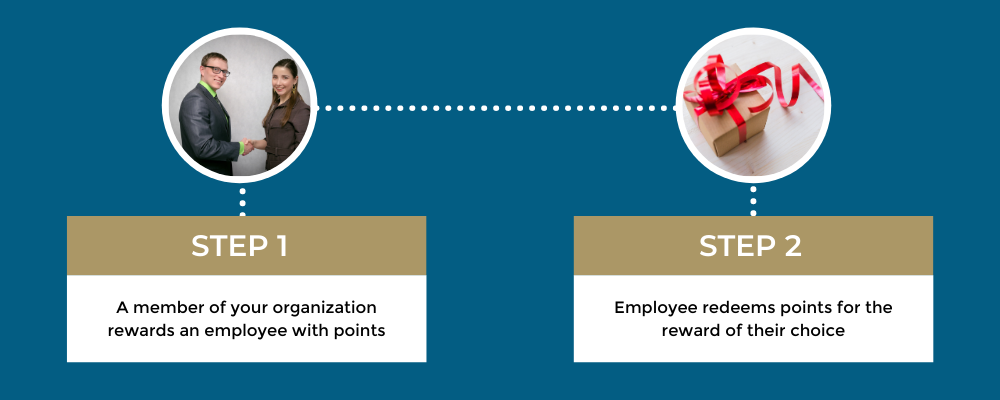
Step 1: A member of your organization rewards an employee with points
Whenever a member of management identifies an employee going above and beyond the call of duty, reflecting the values of your organization, or exhibiting any positive trait which you want to encourage, they can reward the employee with incentive points. To make the most significant impact, the SaaS should also allow an employee’s co-workers to award points as well, but we’ll cover that in a bit.
Step 2: Employee redeems points for the reward of their choice
The recipient can then redeem the points for a reward of their choice. Quality plans will allow your employees the option to bundle their points as well, meaning they can build them up over time to redeem for an even bigger reward.
Keep in mind, award selection will play a vital role in the success of your program.
If your provider’s selection is limited, dated, or is of inferior quality, it will threaten your entire recognition efforts. So before you partner with any provider, take a very close look at their award selection. If you don’t see anything you would want for you or your family, then chances are your employees won't either.
Benefits of values-based incentive programs
Values-based incentive point programs are the key to creating a Culture of Total Recognition at your company. You can check out the official research, but here are a few of the most significant takeaways:
- Employees who participate in values-based recognition programs find meaning and purpose in their work
- When a recognition program is connected with the company’s core values, employees report having a much more positive work experience
- Employees say work performance is more likely to improve when feedback comes from both managers and peers – which is made possible through a values-based incentive program
- Employers report their highest return on investment (ROI) is when they create an environment where employees are rewarded for reflecting their organization's values in the workplace
How a SaaS provider can help
One of the most effective ways you can ensure the success of your YOS award program – and your Total Recognition strategy as a whole – is to work with a proven SaaS provider that specializes in employee recognition.
Keep in mind that services vary greatly depending on the provider.
At a bare minimum, your SaaS solution should include the following features – all of which come standard with C.A. Short Company’s engagement and recognition platform, People Are Everything®:
.png?width=1600&name=PAE_Recognition_Screen_Shot%20(1).png)
 Manage values-based incentive points
Manage values-based incentive points
Your SaaS provider should make managing your values-based incentive program a breeze. This means managers should be able to note positive behavior, view employee point balances, and award points easily.
If managers can’t easily accomplish these tasks, your recognition program will never deliver the results you’re seeking. The same is true for employees. They must be able to easily track and redeem their points.
.png?width=150&name=3%20(1).png)
Encourage peer-to-peer recognition
One of the most effective forms of recognition lies in peer-to-peer recognition. Your solution should offer an inclusive internal communication portal where employees can recognize each other, share stories of appreciation, and even award points.

Encourage lifestyle changes virtually anywhere
The SaaS solution should let you promote positive participation in a team atmosphere no matter where your employees are located – whether they work in the home office, remotely, or even outer space (as long as they have the internet). In addition to offering this functionality, any plan worth its salt will also offer a quality employee wellness program.
 Measure success
Measure success
Your SaaS provider should offer a wide array of tools to help you measure both employee engagement and your return on investment. This can include surveys, benchmarking resources, scoring options, and more.
 Easily correspond with employees
Easily correspond with employees
In addition to letting you send points to your employees, your SaaS should also let you send special correspondence to your employees. This might include eCards for birthdays, holidays, and other special events. Your plan should also include gamification elements, like the awarding of badges.
Next steps
Would you like your Years of Service award ceremony to deliver the greatest possible impact? Do you already have a program in place, but need some help with the awards, certificates, and plaques? Are you considering adopting a Total Recognition strategy?
If you answered yes to any of these questions, please reach out.
We’ve got more than 80 years experience in the employee engagement and recognition industry, and we’d love to help your company invest in your most precious asset — your people!
